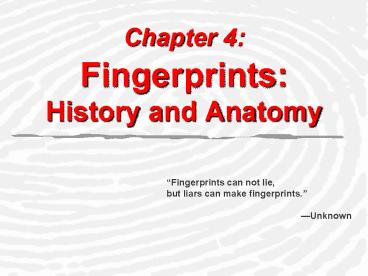Chapter 4: Fingerprints: History and Anatomy - PowerPoint PPT Presentation
1 / 24
Title:
Chapter 4: Fingerprints: History and Anatomy
Description:
Chapter 4: Fingerprints: History and Anatomy Fingerprints can not lie, but liars can make fingerprints. Unknown Chapter 4 Kendall/Hunt Publishing Company ... – PowerPoint PPT presentation
Number of Views:392
Avg rating:3.0/5.0
Title: Chapter 4: Fingerprints: History and Anatomy
1
Chapter 4 FingerprintsHistory and Anatomy
Fingerprints can not lie, but liars can make
fingerprints. Unknown
2
History
- Alphonse Bertillonproposed body measurements as
a means of identification termed ? anthropometry
3
Anthropometry the study of human body
measurements
There were eleven measurements Height Stretch
Length of body from left shoulder
to right middle finger when arm is
raised Bust Length of torso from head to seat,
taken when seated Length of head Crown
to forehead Width of head Temple to temple
Length of right ear Length of left foot Length
of left middle finger Length of left cubit
Elbow to tip of
middle finger Width of cheeks Length of left
little finger
4
Anthropometry Proved Wrong
- Look at book on page 62
5
DactyloscopyThe study of fingerprints
- Historically
- William Herschelrequired Indians to put their
fingerprints/palm prints on contracts as a means
of frightening the businessmen from committing
fraud
6
History
- Henry Faulds ?claimed that fingerprints did not
change over time and that they could be
classified for identification - He is also credited with the first fingerprint
identification of a greasy fingerprint left on an
alcohol bottle
7
History
- Francis Galton ? developed a primary
classification scheme based on loops, arches and
whorls. - Published a book Fingerprints establishing the
individuality and permanence of fingerprints - According to his calculations, the odds of two
individual fingerprints being the same were 1 in
64 billion.
8
History
- Edward Richard Henryin collaboration with Galton
instituted a numerical classification system
9
History
- Juan Vucetichdeveloped a fingerprint
classification based on Galtons that is used in
Spanish-speaking countries - Juan Vucetich made the first criminal fingerprint
identification in 1892. He was able to identify
Francis Rojas, a woman who murdered her two sons
and cut her own throat in an attempt to place
blame on another. Her bloody print was left on a
door post, proving her identity as the murderer.
10
What Are Ridge Patterns?
- Fingerprints are formed in utero
- Three theories as to why we have them
- Evolutionary development that provides better
grip - Makes perspiration easier on a hairless surface
- Improves the sense of touch
- Apes and monkeys have ridge patterns on fingers
and toes
11
(No Transcript)
12
Anatomy of a Fingerprint
- Consists of two main layers
- Epidermis (outer layer) contains the physical
fingerprint - ?Outer layer of epidermis is dead
- ?Inner layer of epidermis is living
- Dermis (inner layer)
- Contains collagen fibers, blood vessels, nerve
endings, glands, sensory receptors, smooth
muscles, and hair follicles - Underneath dermis is a layer of fat called the
hypodermis
13
Anatomy of a Fingerprint
- Dermis contains sweat and sebaceous (oil) glands
- ? Sweat glands help control body temperature
- ? Sebaceous glands produce oils called sebum
- Helps keep epidermis flexible and waterproof
- The sweat and oils sit on the ridges and then are
transferred to an object when touched.
14
Anatomy of a Fingerprint
- ?Dermal papillae separates the epidermis from the
dermis - If an injury occurs above the papillae,
fingerprint will be replaced - If an injury across the papillae, scar will
mostly occur and fingerprint will be slightly
altered
15
Fingerprint Alterations
- A change to a fingerprint can be purposeful or
accidental
16
John Dillinger
- Infamous Depression-era bank robber who tried to
destroy his own fingerprints by pouring acid on
them - DIDNT WORK they still caught him
http//www.fbi.gov/about-us/history/famous-cases/j
ohn-dillinger
17
(No Transcript)
18
Fundamental Principlesof Fingerprints
- ? A fingerprint is an individual characteristic.
- ? A fingerprint will remain unchanged during an
individuals lifetime. - ?Fingerprints have general characteristic ridge
patterns that permit them to be systematically
classified.
19
Loop 60-65
- ?A loop must have one or more ridges entering and
exiting from the same side. Loops must have one
delta. - Types
- Radialopens toward the thumb
- Ulnaropens toward the pinky (little finger)
- Which type of loop is this, if it is on the right
hand? Left hand?
20
Whorl 30-35
- ?A plain or central pocket whorl has at least one
ridge that makes a complete circuit. A double
loop is made of two loops. An accidental is a
pattern not covered by other categories. Whorls
have at least two deltas and a core. - Types
- Plain
- Central Pocket
- Double Loop
- Accidental
21
Arch approximately 5
- ? An arch has friction ridges that enter on one
side of the finger and cross to the other side
while rising upward in the middle. They do NOT
have type lines, deltas, or cores. - Types
- Plain
- Tented
22
Ridge Characteristics
- Minutiae ? characteristics of ridge patterns
- Ridge ending
- Short ridge
- Dot or fragment
- Bifurcation
- Double bifurcation
- Trifurcation
- Bridge
- Island
- Enclosure
- Spur
23
Fingerprint Minutiae
24
(No Transcript)































